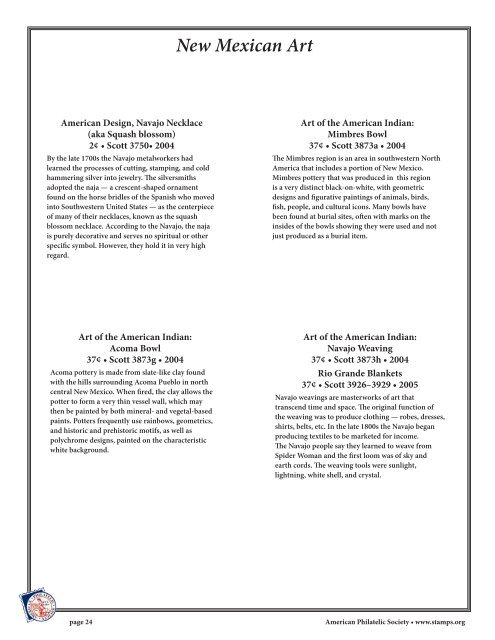New Mexico - American Philatelic Society
New Mexico - American Philatelic Society
New Mexico - American Philatelic Society
You also want an ePaper? Increase the reach of your titles
YUMPU automatically turns print PDFs into web optimized ePapers that Google loves.
<strong>New</strong> Mexican Art<br />
<strong>American</strong> Design, Navajo Necklace<br />
(aka Squash blossom)<br />
2¢ • Scott 3750• 2004<br />
By the late 1700s the Navajo metalworkers had<br />
learned the processes of cutting, stamping, and cold<br />
hammering silver into jewelry. The silversmiths<br />
adopted the naja — a crescent-shaped ornament<br />
found on the horse bridles of the Spanish who moved<br />
into Southwestern United States — as the centerpiece<br />
of many of their necklaces, known as the squash<br />
blossom necklace. According to the Navajo, the naja<br />
is purely decorative and serves no spiritual or other<br />
specific symbol. However, they hold it in very high<br />
regard.<br />
Art of the <strong>American</strong> Indian:<br />
Mimbres Bowl<br />
37¢ • Scott 3873a • 2004<br />
The Mimbres region is an area in southwestern North<br />
America that includes a portion of <strong>New</strong> <strong>Mexico</strong>.<br />
Mimbres pottery that was produced in this region<br />
is a very distinct black-on-white, with geometric<br />
designs and figurative paintings of animals, birds,<br />
fish, people, and cultural icons. Many bowls have<br />
been found at burial sites, often with marks on the<br />
insides of the bowls showing they were used and not<br />
just produced as a burial item.<br />
Art of the <strong>American</strong> Indian:<br />
Acoma Bowl<br />
37¢ • Scott 3873g • 2004<br />
Acoma pottery is made from slate-like clay found<br />
with the hills surrounding Acoma Pueblo in north<br />
central <strong>New</strong> <strong>Mexico</strong>. When fired, the clay allows the<br />
potter to form a very thin vessel wall, which may<br />
then be painted by both mineral- and vegetal-based<br />
paints. Potters frequently use rainbows, geometrics,<br />
and historic and prehistoric motifs, as well as<br />
polychrome designs, painted on the characteristic<br />
white background.<br />
Art of the <strong>American</strong> Indian:<br />
Navajo Weaving<br />
37¢ • Scott 3873h • 2004<br />
Rio Grande Blankets<br />
37¢ • Scott 3926–3929 • 2005<br />
Navajo weavings are masterworks of art that<br />
transcend time and space. The original function of<br />
the weaving was to produce clothing — robes, dresses,<br />
shirts, belts, etc. In the late 1800s the Navajo began<br />
producing textiles to be marketed for income.<br />
The Navajo people say they learned to weave from<br />
Spider Woman and the first loom was of sky and<br />
earth cords. The weaving tools were sunlight,<br />
lightning, white shell, and crystal.<br />
page 24<br />
<strong>American</strong> <strong>Philatelic</strong> <strong>Society</strong> • www.stamps.org

















